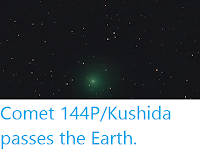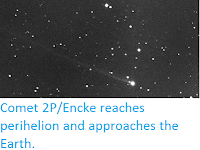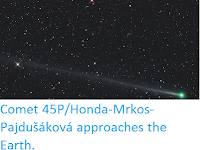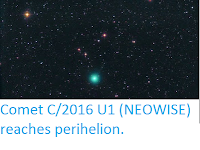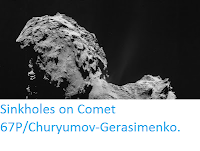Comet 41P/Tuttle-Giacobini-Kresak will pass the Earth at a distance of 21 240 000 km
(0.14 times the distance between the Earth and the Sun) slightly after 0.50 am GMT on Saturday 1 April 2017, its closest approach to
the planet this year. Sadly the comet will not be
naked-eye-visible, achieving a maximum magnitude of about +8, which
means it should be visible with a small telescope or good pair of binoculars.
Image of 41P/Tuttle-Giacobini-Kresak taken on 6 March 2017 by Dwight Talley of Albuquerque in New Mexico, using a TEC 140 mm telescope and a QSI 660 camera. The comet is the point at the centre of the image, the elongate objects are stars, which appear linear as the telescope remained pointing at the comet, which was moving relative to the stars, over a 120 second exposure. Cloudy Nights.
41P/Tuttle-Giacobini-Kresak was discovered on 3 May 1858 by Horace Parnell Tuttle of the Harvard Observatory, and rediscovered independently by Michel Giacobini of the Nice Observatory in 1907 and Ľubor Kresák of the Skalnate Pleso Observatory in 1951. The designation 41P implies that it was the 41st periodic comet ever discovered.
41P/Tuttle-Giacobini-Kresak is a short period, Jupiter Family comet (a comet with a period of less than 20 years) with an orbit angled at less than 30° to the plane of the Solar System), estimated to be about 1.4 km in diameter. It has a 5.42 year orbital period and an elliptical orbit tilted at 9.23° to the plane of the Solar System, which takes it from 1.04 AU from the Sun (i.e 1.04 times as far from the Sun as the Earth) to 5.12 AU from the Sun (i.e. 5.12 times the average distance between the Earth and the Sun, slightly inside the orbit of Jupiter).
See also...
The calculated orbit of 41P/Tuttle-Giacobini-Kresak. The Sky Live/3D Solar System Simulator.
41P/Tuttle-Giacobini-Kresak is a short period, Jupiter Family comet (a comet with a period of less than 20 years) with an orbit angled at less than 30° to the plane of the Solar System), estimated to be about 1.4 km in diameter. It has a 5.42 year orbital period and an elliptical orbit tilted at 9.23° to the plane of the Solar System, which takes it from 1.04 AU from the Sun (i.e 1.04 times as far from the Sun as the Earth) to 5.12 AU from the Sun (i.e. 5.12 times the average distance between the Earth and the Sun, slightly inside the orbit of Jupiter).
See also...
Follow Sciency Thoughts on Facebook.



